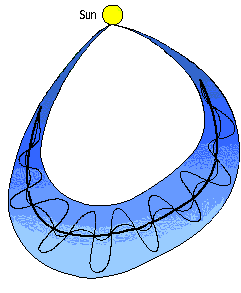


Large transient structures ( ~ 1/4 AU) emanating from the Sun and observed in the solar wind and interacting with it. They are characterized by an enhanced magnetic field intensity, large and smooth magnetic field rotation throughout, and a depressed proton temperature, compared to the ambient plasma. Often a shock wave precedes the magnetic cloud and is driven by it. Magnetic clouds usually cause geomagnetic storms at Earth and the upstream interplanetary shock causes a sudden commencement. The MFI team is studying every aspect of magnetic clouds, including their intrinsic properties, their solar origin, and their interaction with Earth's magnetosphere and its bow shock. A list of times when magnetic clouds are observed by WIND is available.
The very large-scale sheet of electrical current that separates the Sun's magnetic field lines, that are frozen into the solar wind, according to the field's polarity, i.e., toward or away from the Sun. The field regions on either side of this current sheet are referred to as interplanetary sectors, and the number of these change in time. The MFI team studies the large and sometimes small-scale structure of these HCS's, the relationship of the HCS to the Sun, and a so-called plasma sheet that is observed to be associated with it. A list of WIND HCS crossing times is available.
Impulsive MHD discontinuities in the solar wind across which the entropy increases (i.e., causes an increase of disorder in the plasma). These are caused by solar ejecta or magnetic clouds ramming into the solar wind ahead of it or by the overtaking of a slow by a fast solar wind stream. The MFI team is interested in the origin of interplanetary shocks, their intrinsic properties, and how they interact with the Earth. A list of interplanetary shock encounter times is provided.
This is a newly identified MHD structure which consists of an intimate combination of an interplanetary slow shock wave and a rotational discontinuity of usually large discontinuity-angle. First discovered in the solar wind and magnetic field data of the WIND spacecraft (by Prof. Y. C. Whang, Catholic University of America, on the MFI team), these discontinuities have also been observed recently in the magnetotail from other spacecraft observations by the same team.
The shock wave observed just upstream of the Earth's magnetosphere caused by the supersonic and super-Alfvenic solar wind ramming into the Earth's magnetosphere. (SuperAlfvenic refers to when the solar wind's speed exceeds a characteristic speed that depends on the solar wind's density and the interplanetary magnetic field strength.) The MFI team provides a list of all WIND bow shock crossings for use by other scientists, as well as participates in the study of bow shock characteristics under various circumstances.
The overall magnetic environment around the Earth developed by the interaction of the solar wind flowing past the Earth's intrinsic magnetic field. It is sometimes referred to as an elongated cavity in the solar wind caused by this interaction. The magnetic field inside is formed by the sum of the Earth's intrinsic field and those fields from various other sources, including electrical currents on the boundary (called the magnetopause). The downstream side of the magnetosphere is called the magnetotail. The MFI team's interests are mainly in the magnetosphere during geomagnetically active periods and in its boundaries.
The wake behind the Moon caused by the solar wind interacting with it. The WIND spacecraft has passed through this wake numerous times providing some occasions for its intensive study. This interaction excludes the existence of an upstream bow shock, because the solar wind directly impacts the Moon, an electrically insulating body. The MFI team examines many properties of the wake, including comparisons of its cause to other types of solar wind interactions.

Return to the WIND MFI Home Page.
This page last modified June 14, 2001